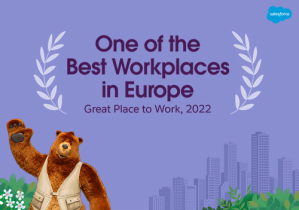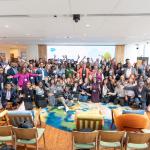At Salesforce, our culture is our cornerstone; it drives everything we do and unifies the organization as we’ve grown to over 78,000 employees. And being named one of the Best Workplaces in Europe by Great Place to Work, a placement determined by employee survey feedback shows that while there is always room for growth, our culture is doing exactly what it should: making Salesforce a great workplace for everyone. Offering employees flexibility has been key to ensuring our employees feel supported and empowered to do their best work.
While some organisations are mandating office returns for their employees, we know that doesn’t work. Instead, Salesforce continues to offer employees the hybrid flexibility to choose when to come into the office for intentional connection. In 2021, Flex Team Agreements were developed to help teams determine how, when and where they will work. These agreements have proven successful in combining individual preferences for productivity with team-based goals.
The benefits of flexibility impact each employee differently. Some find themselves working late at night when their home base is asleep so they can make school drop-offs in the morning- allowing them to be present for important moments outside of work. Others come into their local office a few days a week to collaborate and socialise with their teammates in person, fostering the in-office community that makes our professional wins that much more energizing. Sue Leandro was able to continue her studies and pursue her passion for education while being a full-time Senior Solution Engineer at Salesforce.
Sue arrived at Salesforce in 2021 while attending her last year of university virtually. With a background in Technology and Sciences of Education, she navigated the tech industry for 10 years before joining the Salesforce Solution Engineering team, where she helps UK and Irish customers grow their businesses.
We asked Sue how she was able to balance both the final year of her studies and her duties as a Senior Solution Engineer.
“Joining Salesforce and having access to a flexible work environment has given me years of my life back- I’m not kidding! I was given absolute freedom over my own schedule and how I manage my duties as a Solution Engineer. I was meeting customers in the morning and doing college exams in the afternoon. This was a privilege I didn’t really have before – I always needed to take days off for my college duties. The reality is that I could only do this because of the flexibility of working from home, being able to set up my own boundaries, and being surrounded by incredibly supportive leadership and colleagues. The trust they had in me to take care of our customers, even though my schedule was unusual, was so empowering.
“Fast forward to 2022, I’m able to come into the office once a week and get lunches with my coworkers. And, I now have a Bachelor’s degree in Sciences of Education! I was actually in the office when I got the news I finished my degree! My colleagues were the first ones to know; all the support I got made me feel like I was surrounded by my work family. They took this picture:“
 Sue’s celebration in the Dublin office after finding out she had completed her degree was captured by her colleagues
Sue’s celebration in the Dublin office after finding out she had completed her degree was captured by her colleagues
Sue’s time management and productivity hacks enabled her to succeed as both a Solution Engineer and a student.
By taking advantage of a flexible schedule, Sue has been able to find balance and new strategies for productivity to make the most of her work days. Being a Senior Solution Engineer, there’s never a shortage of tasks or things to do.
Essence Royal, Senior Equality Talent Partner, sat down with her to learn how Sue prioritises that never-ending task list, how she approaches the eight-hour workday, and how she found a refreshing approach to work-life balance. Watch the interview or read the transcript below:

Sue at the Salesforce London Tower with Astro.
How do you prioritise work tasks?
As a Solution Engineer, our priorities are very aligned with our sales organisation. To give our audience a little bit more context: Solution Engineers work as partners or trusted advisors both to customers and the sales organisation when the conversations start to shift towards functional and technical requirements. So the way we prioritise our work really depends on that partnership…Personally, I use something called the Eisenhower Matrix. There are multiple names for it- Eisenhower Method, Eisenhower Box, whatever you want to call it- but in a nutshell, it is a simple decision-making tool that helps you look at your overall tasks from an “importance versus urgency” perspective.
I hope that people hear us talk about the Eisenhower Method and go immediately to Google it! The Eisenhower Method is a simple tool for considering the longer-term outcomes of your daily tasks and focus[es] on what makes you most effective, and not just the most productive. Like I said, it helps you visualise all your tasks in the matrix of urgent versus important and all of your day-to-day tasks or bigger projects will fall into four quadrants.
Everyone should try the Eisenhower Matrix if they find themselves running around putting fires out all day, figuratively speaking, are busy but don’t feel like their work has a high impact, have a hard time delegating or saying no (we’ve all been there). Or, you know, if they want to be the President of the United States because- hey, it worked for Eisenhower, it might work for someone else too!
How do you balance an eight-hour workday?
That’s the question I love being asked because I am a strong believer that the eight-hour workday is an outdated idea. But hear me out: I’ve found a way around it. I read a study conducted by the Draugiem Group that completely changed my approach: while measuring people’s activities, they stumbled upon a fascinating finding. The length of a workday didn’t matter much. What mattered was how people structured their day. In particular, people who were stricter about taking short breaks were far more productive than those who worked longer hours. So hey…if you need a sign to take a break, here it is! I am that sign.
They discovered, or they proved, that our brain wants an hour on, and 15 minutes off. And by using this magic productivity ratio, we tapped into a fundamental need of the human mind. The brain naturally functions in spurts of high energy, roughly an hour, followed by spurts of low energy, which are those 15-minute breaks that we all need so much.
So, the eight-hour workday works for me if I break my time into strategic intervals. Honestly, once I finally aligned my natural energy with these efforts, things began to run much more smoothly for me.
When should you seek outside help for help with workload?
The short answer is; if you feel anxious. And whether that’s feeling anxious about a task, or feeling anxious about coming to work. Now, if you don’t have any anxiety- lucky you!- you can realise, for example, that your eight hours are just not enough to cover everything. For example, they are not enough for you to do the training that you want [to do], and you know that’s not okay. You need to have time for yourself.
I also believe there’s a management component in there. It’s known that excessive workloads will normally become evident in the number of hours worked, the turnover, the sickness absence, and the overall productivity rates that our management reads. So, in my opinion, the most important part is to communicate— to have an open communication channel so that the employees can raise their hands when help is needed. But also, managers can reach out if they see that something is changing, whether that’s behaviour or productivity rate.
What are the most important things to remember when prioritising tasks?
When prioritising tasks, always remember to prioritise your breaks and your needs, too. I also like to make sure that I have time and space for the things that give me pleasure about being a Solution Engineer. So when you are organising your day, when you are prioritising your tasks, make sure you have breaks in there, make sure you have time to do the things you like the most, and make sure you have time for yourself.
Why is it important to have a work-life balance?
Oh, I have so many reasons! First of all, I think our definition of work-life balance changed completely during the past two years. When I think about what work-life balance means, most of us envision equalising a seesaw with work on one side and the rest of our lives on the other side. And we think that we are supposed to equalise both sides, focusing on the amount of time we spend on each side. I believe that’s why so many work-life balance ideas revolve around managing our time, or, for example, adopting productivity hacks. But for me, there’s just one problem: time isn’t the real problem anymore. I’m home all the time. I spend time with my family all the time. I just can’t balance my life in that seesaw way anymore.
I think that was the hardest thing that we needed to change during the past two years. So when I started to dig deep into what work-life balance would look like for me, I found that I’m pulled towards things like making a bigger impact in the world or making a bigger impact as a Solution Engineer. Prioritise what’s important to me, have strong boundaries that I feel good about enforcing, and finally, let go of trying to do it all…For me, work-life balance is really about feeling content in who I am and content with the decisions that I am making, and honestly, it’s not something that you find. It’s really something that you create, and sometimes you create it by making tough decisions.
Success from Anywhere. Careers everywhere.
Learn more about how Salesforce empowers employees to achieve Success From Anywhere.

























